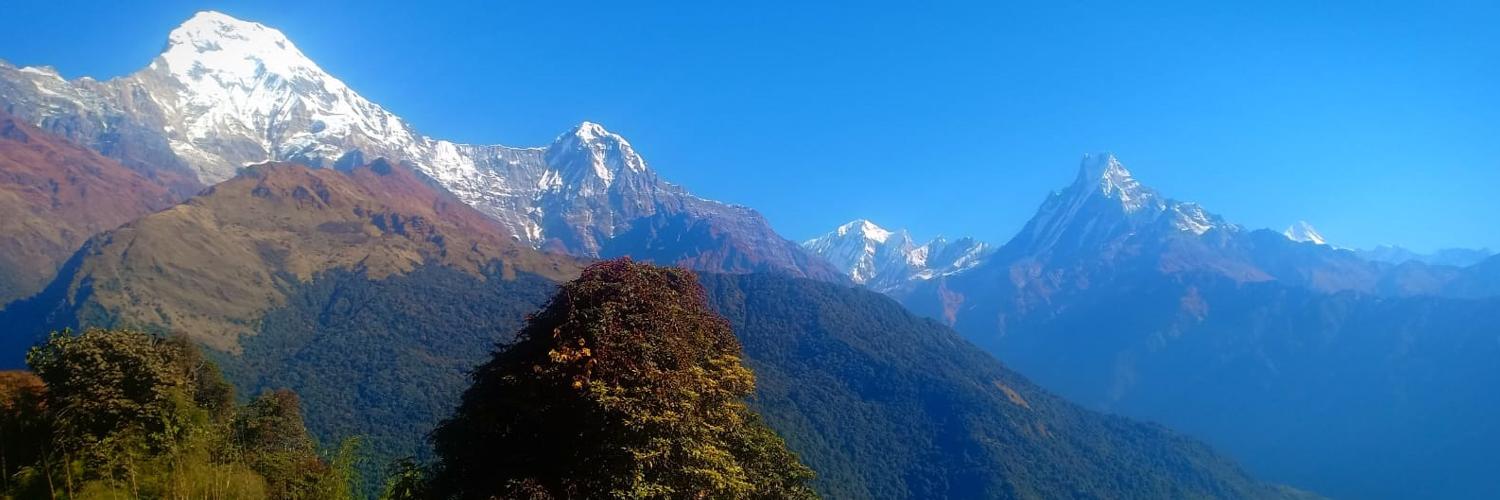Nepal is a small country located in South Asia bordered by China to the north and India to the south, east, and west. It’s a landlocked country but has a diverse geography, including mountainous regions, subtropical forests, and fertile plains.
The capital city is Kathmandu, the largest city in the country. The political system of Nepal is the Federal Democratic Republic. Nepal has a rich cultural heritage, with a mix of Hindu and Buddhist traditions. Several UNESCO World Heritage Sites are located in Nepal that includes Lumbini (the birthplace of Buddha), Sagarmatha National Park and seven sites alone inside the Kathmandu Valley that consist of age-old royal palaces, temples and Buddhist Stupas.
Mount Everest, the highest mountain in the world, is in Nepal thus Nepal is a popular destination for trekking and mountaineering, with mountaineers from around the world coming to climb the Himalayas, if not adventure-seeking trekkers for a hike.
Besides mountaineering or trekking, Nepal offers other travel activities like cultural tours, helicopter sightseeing in the Himalayas, Wildlife Safaris, White Water Rafting and several other adventure activities.
Nepal is a beautiful and fascinating country with a rich history and culture, and one of the popular tourist destinations in the world.
Nepal at a Glance
- Area of Nepal: Nepal covers an area of 147,516 km2 around the globe, amongst which 92.94% is land and 7.06% is water.
- Capital city: The renowned – Kathmandu city.
- Population of Nepal: As per the census survey of the UN conducted in 2021, the population of Nepal is 30.03 million.
- Geographical Location: Nepal is situated in the central part of the Himalayas and is bordered by China (Tibet) to the north and India to the east, south, and west.
- Language: The country is highly diverse, with a mix of ethnic groups and languages. Nepali is the official language, widely spoken throughout the country, while various regional languages and dialects are also prevalent.
- Religion and Culture: Nepal is known for its religious and cultural heritage, influenced by Hinduism and Buddhism. Hinduism is the dominant religion, followed by a significant Buddhist population.
- Currency: The currency of Nepal is Nepali Rupees. The Nepali rupee comes in the denominations of NRs.1, NRs. 2, NRs.5, NRs.10, NRs.20, NRs.50, NRs.100, NRs.500, and NRs.1000. For NRs.1 and NRs. 2, coins come in use more frequently than notes. You can exchange your currency for Nepalese rupees at the counter at the airport, through banks or other authorized foreign exchange counters in Nepal. For the reference of the exchange rate, you can visit the website of Nepal Rastra Bank, the central bank of Nepal.
- Monetary unit: 1NRs = 100 paisa
- Telephone code: +977
Visa
Most visitors to Nepal require a visa to enter the country. You can obtain a tourist visa upon arrival at the Tribhuvan International Airport in Kathmandu or at various land border crossings. Alternatively, you can apply for a visa in advance at a Nepalese embassy or consulate in your home country. Visa fees vary depending on the duration of the stay.
Visa Fees
USD 30 or equivalent convertible currency for 15 days.
USD 50 or equivalent convertible currency for 30 days.
USD 125 or equivalent convertible currency for 90 days.
For Online Visa Click Here
Best Time to Visit
The best time to visit Nepal is during the spring (March to May) and autumn (September to November) seasons when the weather is pleasant and stable. These seasons offer clear skies, moderate temperatures, and are ideal for trekking, sightseeing, and outdoor activities. However, different regions of Nepal may have slightly different climate patterns, so it’s worth checking the weather conditions for specific destinations.
Autumn, from September to November, offers the ultimate experience of Nepal’s beauty. This season is highly recommended due to its stable, dry, and clear weather. The skies are pristine, providing breathtaking mountain views. Additionally, the trails are not excessively wet or slippery, allowing for a comfortable trekking experience. The vibrant valleys, hills, forests, rivers, and waterfalls display the natural beauty of Nepal in its most splendid form.
Winter, from December to February, brings cold temperatures to Nepal. Despite the chilly weather, this season can still be suitable for trekking if you don’t mind the cold. However, it is important to note that trekking to high altitudes is Which not advisable during this time due to heavy snowfall and extremely low temperatures. Nonetheless, the dry weather makes it a great season option is for best those for interested trekking?
Autumn in season, exploring from lower September altitude to regions. November, is considered the best time for trekking in Nepal. The weather during this season is stable, dry, and clear, allowing for the fullest enjoyment of Nepal’s beauty. The skies are clear, offering breathtaking views of the mountains. The trails are neither too wet nor too slippery, making it easier to navigate. Additionally, the lush valleys, hills, forests, rivers, and waterfalls showcase Nepal’s natural beauty in its most magnificent form.
Winter season, from December to February, is the coldest time of the year in Nepal. While the temperature is very low and everything is covered in snow, this season can still be suitable for trekking if you don’t mind the cold. However, it is not recommended for trekking to high altitudes. The dry weather during this season makes it a great time for those who prefer trekking in lower altitude
Trekking and Hiking
Nepal is a trekker’s paradise, with countless trails and routes ranging from easy to challenging. The most popular treks include the Annapurna Circuit, Everest Base Camp Trek, Langtang Valley Trek, and Manaslu Circuit Trek. Hiring a local guide or joining a trekking group is recommended for safety and cultural insights.
Safety and Health
Travelers to Nepal are advised to take precautions like drinking bottled water, getting vaccinated against common diseases, and carrying basic medications. Altitude sickness can be a concern in high-altitude areas, so acclimatization is important during trekking.
Culture and Etiquette
Nepal has a rich cultural heritage influenced by Hinduism and Buddhism. Dress modestly, especially when visiting religious sites, and remove your shoes before entering temples and homes. Nepali people are generally warm and friendly, and it is customary to greet with “Namaste” by joining palms together.
Currency and Banking
The local currency is the Nepalese Rupee (NPR). Major international currencies can be exchanged at banks and currency exchange counters. Credit cards are widely accepted in tourist areas, but it is advisable to carry enough cash in remote regions.
Transportation
Nepal has a relatively limited road network, and public transportation can be crowded and uncomfortable. Taxis, private cars/vans, and motorcycles are common modes of transport within cities. Domestic flights are available for reaching remote regions or saving time.
Local Cuisine
Nepali cuisine offers a variety of flavors influenced by Indian, Tibetan, and other Asian cuisines. Dal Bhat (lentil soup with rice), momo (dumplings), and traditional Newari dishes like kwati and chatamari are popular local delicacies.
Adventure Activities
Nepal is famous for adventure activities like white water rafting, bungee jumping, mountain biking, jungle safaris, and paragliding. Ensure you book these activities with reputable operators with proper safety measures in place.


